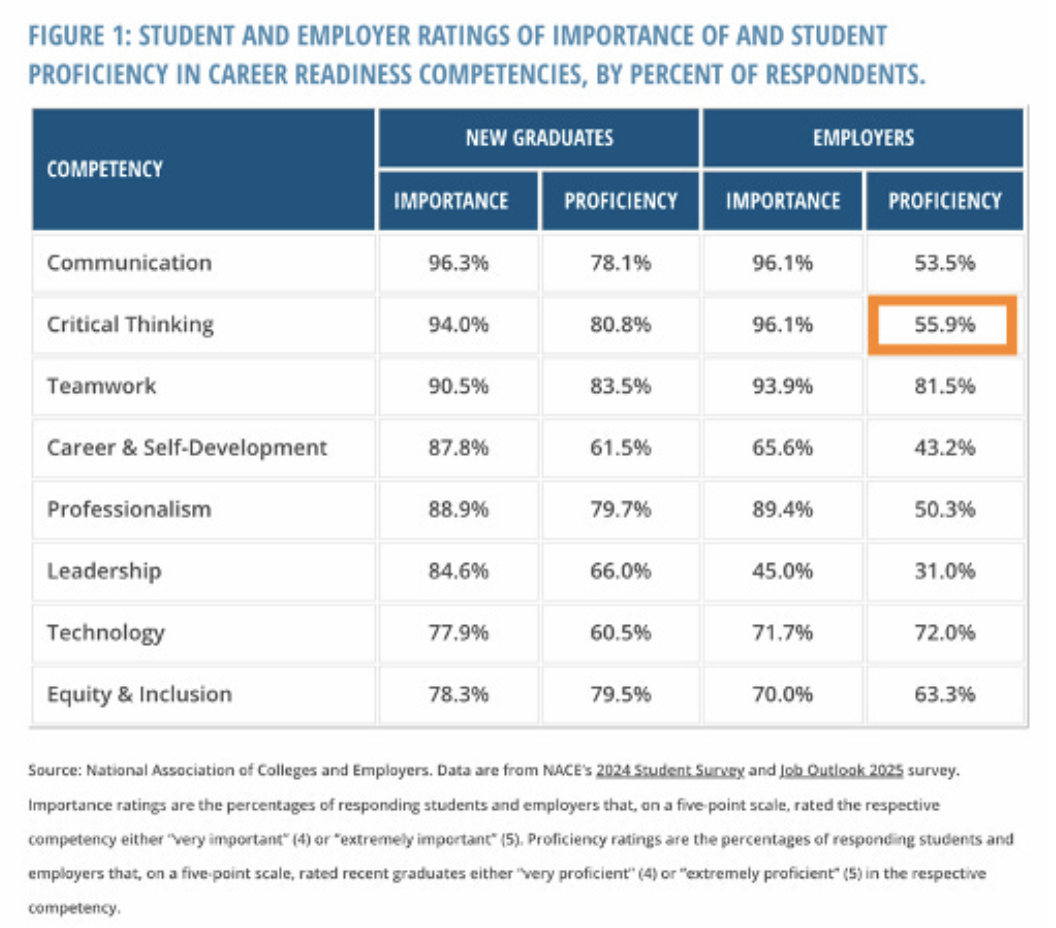
As I dug into weekend reading—coffee in one hand, NACE’s 2024 briefing (which I have been dying to read) in the other one chart stopped me cold based on my thinking lately.
Eight familiar “career-readiness” skills stacked side-by-side, student self-scores on the left, employer reality checks on the right. The bars didn’t just diverge; they yanked in opposite directions. That single visual punch (in the gut) is why I “tried to write this”.
“Confidence without evidence is just bravado.”
Bookmark that before you post another “future-ready” graduation photo.
0️⃣ Higher-Ed Canary or One-Off Blip?
The NACE gap isn’t a glitch; it’s a trend line. Employer polls now show a growing share of hiring managers bypassing fresh grads because “they’ll need too much coaching.”
Generative AI pours fuel on that fire: lecture delivery and rote testing (memorization) are suddenly commodities. When content is free, capability is king. The NACE numbers are simply the SCOREBOARD lighting up the cost of not pivoting fast enough.
1️⃣ The Numbers
NACE—the National Association of Colleges & Employers—links 18 000+ campus career centers with corporate recruiters.
-
Student Survey → Mar – May 2024, 20 482 undergrads (2 281 graduating seniors)
-
Job Outlook → Aug – Sep 2024, 237 organizations across every major sector
Identical questions, large samples, transparent methodology. Ignore at your strategic peril.
3️⃣ Why the Gap Persists—and What We’re Getting Wrong
A. Four Forces Keeping the Chasm Open
-
Self-assessment inflation – classrooms reward completion; workplaces reward outcomes.
-
Credential ≠ competence – diplomas signal knowledge, not behavior.
-
Flimsy proof – résumés list claims; recruiters discount them by default.
-
Half-life of skills = months – AI rewrites “good” faster than syllabus or L&D calendars can pivot.
B. Teaching vs. Doing — Where the Classroom-to-Cubicle Flip Still Trips Us Up
Most colleges run on the download model: professors talk, students take notes, exams test recall.
Employers pay for the do-something model: tackle messy, moving targets and ship results before lunch.
Studying can’t expose the blind spots that surface the first time a client says “prove it.” Doing can.
AI cranks the contrast—any bot can summarize a lecture, but only a human can de-escalate a furious customer at 4 p.m.
C. Whose Job Is It—Employer or Candidate?
Both, or nobody wins.
-
Candidates must treat career readiness like a product launch: validate, build evidence, iterate.
-
Employers waiting for shrink-wrapped, leadership-savvy talent will bleed productivity. Finishing the last mile internally is faster—and cheaper—than rehiring.
Think relay race: campus runs three legs, industry sprints the anchor. Drop the baton anywhere and everyone loses.
D. Five Campus Moves You Can Launch (or encourage your student or yourself) for this semester
-
Turn every 300-level course into a deliverable factory. Artefacts graded on evidence, not attendance.
-
Import the buyer. 90-minute clinics co-taught by hiring managers on one skill (“Critical Thinking in Product Ops”).
-
Badge what matters. Skills-based transcripts travel farther in an Applicant Tracking System than GPA decimals.
-
Coach evidence, not adjectives. Career-services meetings become storytelling drills (“Show me where you led.”) not lists of places to apply online.
-
Run reverse-mentorships. Seniors teach freshmen AI tools while faculty score leadership behaviors—two gaps closed in one shot. (an idea I am using)
E. Should the Skills Relay Start One Stop Earlier—High School?
Absolutely—if we rethink what “prep” means.
-
Early exposure beats late remediation. Neuro-plasticity (the brain’s ability to change and adapt) is on our side in 9th grade.
-
Dual-credit must drive artefacts, not just credits. Show the work, not the checkbox.
-
CTE (Career and Technical Education) is already do-something territory. Bolt the NACE framework on and scale.
-
AI tutors free teachers for coaching, not worksheets.
Pushback: “Let kids be kids.” They’re already content creators on TikTok. Guiding that energy toward market-ready skills isn’t stealing childhood; it’s future-proofing it.
4️⃣ What HR & TA Teams Can Do This Quarter
-
Replace résumé screens with skill simulations. Evidence > claims.
-
Embed micro-upskilling in onboarding. Cheaper than post-probation failure.
-
Make leadership a rotation, not a promotion. Shrink the 35-point deficit early.
-
Exploit the tech upside. Students under-sell their own tech chops—capitalise.
-
Instrument the loop. Pulse managers at 30 / 60 / 90 days on the eight competencies; feed results straight to L&D design.
5️⃣ The AI-First Lens
Generative AI isn’t a training module—it’s an always-on coaching platform:
-
Conversational simulations for thorny leadership moments 24 / 7.
-
Real-time feedback that flags filler words and nudges communication clarity.
-
Skills clouds that map assessed proficiency to project demand on Day 1.
AI exposes the gap—and gives us the scaffolding to close it faster than any curriculum committee ever could.
6️⃣ Call to Action
Educators, employers, parents, students—pick up the baton in your lane and run. The gap is a design flaw and STASIS, not destiny.
Mind the skills gap—or watch productivity fall through it.
7️⃣ The Bottom Line (Strong Close)
“If we wait until graduation to build real-world muscle, we’re basically outfitting firefighters after the fire has started.”
Degrees will matter to a “degree” in some areas, but demonstrated capability is the new tuition. The winners—whether campuses, companies, or individual learners—will be the ones who treat skills like a living balance-sheet item, not a line in a course catalog.
“Skills aren’t born; they’re built. The only question is whether we build them by design or by accident.”
